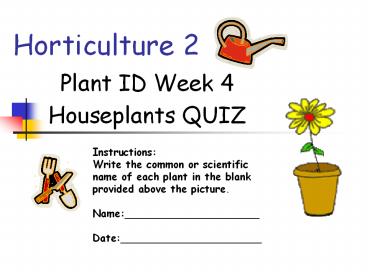Horticulture 2 - PowerPoint PPT Presentation
Horticulture 2
Plant ID Week 4 Houseplants QUIZ Instructions: Write the common or scientific name of each plant in the blank provided above the picture. Name:_____ Date:_____ – PowerPoint PPT presentation
Title: Horticulture 2
1
Horticulture 2
- Plant ID Week 4
- Houseplants QUIZ
Instructions Write the common or scientific name
of each plant in the blank provided above the
picture. Name_____________________ Date_______
_______________
2
1)___________________
- Long fronds instead of leaves.
- Propagation can be done from spores, runners, or
by division . - Originated from tropical regions and doesnt
overwinter. - Thrives in rich humus, partial shade, and high
humidity.
3
2)_____________________
- Great for hanging baskets.
- Prolific grower.
- Has small white flowers in the summer.
- Can easily be propagated by cuttings.
4
3)___________________
- Elastic leaves and stems and wood 'bleeds' white
sticky sap - evergreen shrub or tree native to India
- Used here as an indoor plant
- Large, rubbery leaves are about 5-6 inches long
5
4)____________________________
- Heart shaped leaves
- Can easily be trained up a totem pole.
- An easy houseplant in low light conditions.
- Easy to propagate
- by placing cuttings
- in water.
6
5)_____________________
- Evergreen native to Norfolk Island near
Australia. - Often seen at Christmas as a container plant.
- Flat branches with short, soft needles.
7
6)_____________________
- Indoor plant native to New Zealand.
- Dark greenish brown leaves are saw toothed and
usually 4 inches long and only ½ inch wide.
8
7)___________
- having large usually
- woolly leaves with purple
- edges
- Need lots of light to
- keep bright leaf color.
9
8)____________________
- Dense foliage on a small indoor tree.
- Long slender leaves
- Stems are often trained to grow in ornamental
patterns such as a braid or twist in the trunk.
PowerShow.com is a leading presentation sharing website. It has millions of presentations already uploaded and available with 1,000s more being uploaded by its users every day. Whatever your area of interest, here you’ll be able to find and view presentations you’ll love and possibly download. And, best of all, it is completely free and easy to use.
You might even have a presentation you’d like to share with others. If so, just upload it to PowerShow.com. We’ll convert it to an HTML5 slideshow that includes all the media types you’ve already added: audio, video, music, pictures, animations and transition effects. Then you can share it with your target audience as well as PowerShow.com’s millions of monthly visitors. And, again, it’s all free.
About the Developers
PowerShow.com is brought to you by CrystalGraphics, the award-winning developer and market-leading publisher of rich-media enhancement products for presentations. Our product offerings include millions of PowerPoint templates, diagrams, animated 3D characters and more.































